Menstrual Cycling Monitoring is an important factor in women sports. It has a huge impact on training, performance and recovery of female athletes.
Introduction
Optimizing sports performance for female athletes is difficult. Especially in female sports teams, each individual player is impacted by her menstrual cycle differently and need different adaptations for optimal performance, recovery and injury prevention. Where do we start to apply the menstrual cycle within the existing structures? Discover the first steps for improving sports performance across the menstrual cycle in a team setting. Finishing with part three: how to adapt the way we train to optimize performance in all menstrual phases.
Adapting football or field hockey trainings to the menstrual cycle
The strengths and weaknesses of female athletes during their menstrual cycle can be used to adapt the way we train, so we can optimize performance and prevent injuries. However, there is still a lot that we don’t know. The benefits of menstrual cycle-based training are very small and not consistently proven by research. And taking the adaptation of the training schedules a step too far might have the opposite effect, where players become less resilient and only feel comfortable performing for a few days every month. It can be difficult to find the right balance within a sports team, where all individual players have their own experience with their menstrual cycles. Focusing on what players need to perform their best despite the menstrual phase they are in is the first step in adapting the way we train to the menstrual cycle.
Apply cycle-specific football or field hockey warming-up
For some players, certain menstrual phases might call for a bit more preparation before they can maximally perform in trainings or matches. In the menstrual phase, it can be useful to focus on the reduction of menstrual symptoms during the warming-up to make the players feel more comfortable to start their training or match. Taking some extra time for stretching exercises can help to reduce lower back pain and cramps.
Focus on relevant football & field hockey recovery strategies
Around the ovulation phase when estrogen levels peak, warming-up could focus extra on the prevention of ACL rupture in some players. There is some evidence that a combination of balance training, jumping exercises, stretching and strength exercises can help to reduce the risk of ACL rupture in some players. However, it is important to make sure that the extra focus on this injury prevention does not lead to an increased fear of injury in these players. When athletes are afraid of rupturing their ACL, this is related to changes in movement dynamics and an increased risk of sustaining this injury. Implementation of ACL-specific warming-up might be more suitable across all menstrual phases to generally decrease the risk of ACL rupture in all players, especially since scientific proof for the relationship between the menstrual cycle and injury risk is limited.
Know the importance of nutrition
Proper nutrition plays an important role in the exercise performance of all athletes. The menstrual cycle can influence the type of nutrients the body might need for better recovery, injury prevention and performance readiness. The intake of carbohydrates shortly after exercise promotes better recovery, so that can be beneficial especially in the menstrual and luteal phase where the body might need some extra support in the recovery process. The intake of enough protein can also help during these phases, to support the repair of damaged muscles after exercise. During the menstrual phase it is important to focus on the intake of enough iron, to prevent iron deficiency especially in athletes suffering from heavy menstrual bleeding.
Reduce training load when needed
For some players, there might be moments where changes in warming-up, recovery and nutrition are not enough to make her ready to perform her best. In this case it can be suitable to reduce the training load for this specific player, especially in the days before matches to make sure she will be ready to perform again at important moments.
How to bring it all together: communication and flexible football & field hockey training schedules in practice
The menstrual cycle is one of the many factors impacting the sports performance of female athletes: we should not forget the importance of sleep, mental wellbeing and the general fitness of the players. For the optimization of female performance, we should try to implement the menstrual cycle into the communication and training schedules of sports teams. There is no “one-size-fits-all” solution to the menstrual cycle in sports, but open conversation and flexible adaptations form a basis to make all players perform their best. The combination of measurable performance parameters and the player’s perception as collected using the Johan Sports tracker and app gives the possibility to implement the influence of the menstrual cycle in the way we currently train.

Figure 1: The gas tank approach for adapting football & field hockey training schedules in practice
An example of how the menstrual cycle can be implemented within the existing structures is the gas tank approach. The analogy of a gas tank full of energy can be used in the communication surrounding the menstrual cycle and other relevant factors player readiness and also poses some possible adjustments to the training schedule following the changing gas tank levels.
Conclusion
By adapting training schedules to the menstrual cycle, we keep athletes healthy, available and performance at their best. Open communication + smart adjustments = stronger teams.

Figure 2: Adapting football and field hockey training schedules to the menstrual cycle — where performance meets wellbeing, by Johan Sports.
Author Blog: Maartje Kuperus
Learn more about the Johan Sports tools that help assess the impact of the menstrual cycle on football and field hockey performance.
References:
Chen, H. M., & Hu, H. M. (2019). Randomized Trial of Modified Stretching Exercise Program for Menstrual Low Back Pain. Western Journal of Nursing Research, 41(2), 238–257.
Hausswirth, C., & Le Meur, Y. (2011). Physiological and nutritional aspects of post-exercise recovery: Specific recommendations for female athletes. Sports Medicine, 41(10), 861–882.
Mehl, J., Diermeier, T., Herbst, E., Imhoff, A. B., Stoffels, T., Zantop, T., Petersen, W., & Achtnich, A. (2018). Evidence-based concepts for prevention of knee and ACL injuries. 2017 guidelines of the ligament committee of the German Knee Society (DKG). Archives of Orthopaedic and Trauma Surgery, 138(1), 51–61.
Moore, S. R., Bruinvels, G., & Smith-Ryan, A. E. (2025). Menstrual Cycle Phase-Based Strength and Conditioning Training for Elite Team Sport Female Athletes. Strength and Conditioning Journal, 47(3), 340–352.
